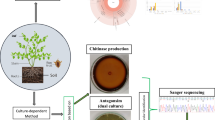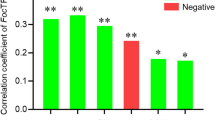Abstract
Since the importance of spices in the global nutritional challenges has been understudied, our aim was to assess the arbuscular mycorrhizal diversity associated with one of the most expensive spices - Saffron (Crocus sativus) in the Kashmir Himalaya.
We used both morphological and molecular approaches to characterize the arbuscular mycorrhizal fungal (AMF) diversity associated with saffron targeting nuclear ribosomal DNA sequences. In order to capture the entire AMF diversity associated with saffron, we assessed the spore density and diversity in rhizospheric soils, and sampled roots from sampling sites spread across major saffron growing area of Kashmir overlying a grid map on the target fields. Genomic DNA was extracted from roots, amplified using nested PCR with two set of primers, sequenced and phylogenetically analysed.
Based on morphological and molecular characterization, 15 different AMF species were found associated with saffron in Kashmir Himalaya, India. The most dominant species was Rhizophagus intraradices followed by Funneliformis mosseae, while the least dominant one was Acaulospora trappei.
In view of the deteriorating quality and yield of saffron over the years in this Himalayan valley, tapping the beneficial soil microorganisms, such as AMF promises to be of help. The implications of these results for formulation of effective biofertilizers for improving yield and quality of saffron vis-à-vis regional nutritional security are discussed.





Similar content being viewed by others
References
Aimo S, Gosetti F, Agostino GD, Gamalero E, GianottiV,Bottaro M, Gennaro MC, Berta G (2010) Use of arbascularmycorrhizal fungi and beneficial soil bacteria to improve yield and quality of Saffron (Crocus sativus L.). Acta Hort 850:159–164. doi:https://doi.org/10.17660/ActaHortic.2010.850.25
Berruti A, Lumini E, Balestrini R, Bianciotto V (2015) Arbuscular Mycorrhizal Fungi as Natural Biofertilizers: Let’s Benefit from Past Successes. Front Microbiol 6:1559. https://doi.org/10.3389/fmicb.2015.01559
Bona E, Cantamessa S, Massa N, Manassero P, Marsano F, Copetta A et al (2017) Arbuscular mycorrhizal fungi and plant growth-promoting pseudomonads improve yield, quality and nutritional value of tomato: a field study. Mycorrhiza 27:1–11. https://doi.org/10.1007/s00572-016-0727-y
Brundrett MC, Melville L, Peterson L (1994) Practical methods in mycorrhizal research Mycologue Publications, Ontario, Canada p. 161
Caser M, Demasi S, Victorino ÍMM, Donno D, Faccio A, Lumini E, Scariot V (2019) Arbuscular mycorrhizal fungi modulate the crop performance and metabolic profile of saffron in soilless cultivation. Agronomy 9:232. https://doi.org/10.3390/agronomy9050232
Caser M, Victorino IMM, Demasi S, Berruti A, Lumini E, Bianciotto V, Scariot V (2020) Arbuscular mycorrhizal fungi association promotes corm multiplication in potted saffron (Crocus sativus L.) plants. Acta Hortic 1287:441–446. doi:https://doi.org/10.17660/ActaHortic.2020.1287.56
Castellanos-Morales V, Villegas J, Wendelin S, Vierheiling H, Eder R, Cardenas-Navarro R (2010) Root colonization by the arbuscular mycorrhizal fungus Glomus intraradices alters the quality of strawberry fruit (Fragaria ananassa Duch.) at different nitrogen levels. J Sci Food Agric 90:1774–1782
Chamkhi I, Abbas Y, Tarmoun K, Aurag J, Sbabou L (2019) Morphological and molecular characterization of arbuscular mycorrhizal fungal communities inhabiting the roots and the soil of saffron (Crocus sativus L.) under different agricultural management practices. Arch Agron Soil Sci 65:1035–1048. https://doi.org/10.1080/03650340.2018.1548012
Diédhiou AG1, Borges WL, Sadio O, de Sergio Miana S (2014) Assessment of DNA extraction methods for detection of arbuscular mycorrhizal fungi in plant roots by nested-PCR.Acta Sci Biol Sci 433–441
Fortin JA, Declerck S, Strullu DG (2005) In vitro culture of mycorrhizas. In: Declerck S, Strullu D-G, Fortin JA. eds. In vitro culture of mycorrhizas. Springer. Berlin, Heidelberg. pp. 3–14
Gerdemann JW, Nicolson TH (1963) Spores of mycorrhizal endogone species extracted from soil by wet-sieving and decanting.Trans Brit Mycol Soc:235–244
Godfray HCJ, Beddington JR, Crute IR et al (2010) Food security: the challenge of feeding 9 billion people. Science 327:812–818. DOI: https://doi.org/10.1126/science.11853
Gomiero T (2016) Soil degradation, land scarcity and food security: reviewing a complex challenge. Sustainability 8:281. https://doi.org/10.3390/su8030281
Grassini P, Eskridge KM, Cassman KG (2013) Distinguishing between yield advances and yield plateaus in historical crop production trends. Nat Comm 4:2918. https://doi.org/10.1038/ncomms3918
Hibbett DS, Binder M, Bischoff JF, Blackwell M, Cannon PF et al (2007) A higher-level phylogenetic classification of the Fungi. Mycol res 111:509–547. https://doi.org/10.1016/j.mycres.2007.03.004
Jami N, Rahimi A, Naghizadeh M, Sedaghati E (2020) Investigating the use of different levels of Mycorrhiza and Vermicompost on quantitative and qualitative yield of saffron (Crocus sativus L.). Sci Hortic 262:109027. https://doi.org/10.1016/j.scienta.2019.109027
Kaloo MJ, Patidar R, Choure T (2014) Status of saffron in Jammu and Kashmir: An economic analysis. Int J Res 4:2348–6848
Koocheki A, Siahmarguee A, Azizi G, Jahani M (2011) The effect of high density and depth of planting on agronomic characteristic of Saffron (Crocus sativus L.) and corms behavior. J Agroecol 3:36–49
Koocheki A, Seyyedi SM (2015) Relationship between nitrogen and phosphorus use efficiency in saffron (Crocus sativus L.) as affected by mother corm size and fertilization. Ind Crops Prod 71:128–137. 10.1016/j. indcrop.2015.03.085
Koocheki A, Seyyedi SM, Jamshid ME (2014) Irrigation levels and dense planting affect flower yield and phosphorus concentration of saffron corms under semi-arid region of Mashhad Northeast. Iran J Hortic Sci 180:147–155. https://doi.org/10.1016/j.scienta.2014.10.031
Krüger M, Krüger C, Walker C, Stockinger H, Schüβler A (2012) Phylogenetic reference data for systematics and phylotaxonomy of Arbuscular mycorrhizal fungi from phylum to species level. New Phytol 193:970–984. https://doi.org/10.1111/j.1469-8137.2011.03962.x
Kumar R, Singh V, Devi K, SharmaM, Singh MK, Ahuja PS (2009) State of art of saffron (Crocus sativus L.) agronomy: a comprehensive review. Food Rev Int 25:44–85. doi:https://doi.org/10.1080/87559120802458503
Lee EH, Eo JK, Ka KH, Eom AH (2013) Diversity of Arbuscular Mycorrhizal Fungi and Their Roles in Ecosystems. Mycobiology 41:121–125. https://doi.org/10.5941/MYCO.2013.41.3.121
Lone R, Shuab R, Koul KK (2016) AMF association and their effect on metabolite mobilization, mineral nutrition and nitrogen assimilating enzymes in saffron (Crocus sativus) plant. J Plant Nutr 1852–1862. https://doi.org/10.1080/01904167.2016.1170850
McBratney A, Field DJ, Koch A (2014) The dimensions of soil security. Geoderma 213:203–213. https://doi.org/10.1016/j.geoderma.2013.08.013
Mensah JA, Koch AM, Antunes PM, Kiers ET, Hart M, Bucking H (2015) High functional diversity within species of arbuscular mycorrhizal fungi is associated with differences in phosphate and nitrogen uptake and fungal phosphate metabolism. Mycorrhiza 25:533–546. https://doi.org/10.1007/s00572-015-0631-x
Menia M, Iqbal S, Zahida R, Tahir S, Kanth RH, Saad A, Hussian A (2018) Production technology of saffron for enhancing productivity. J Pharmacogn Phytochem 7:1033–1039
Nilsson RH, Kristiansson E, Ryberg M, Hallenberg N, Larsson KH (2008) Intraspecific ITS variability in the kingdom Fungi as expressed in the international sequence databases and its implications for molecular species identification. EvolBioinform4:193–201. https://doi.org/10.4137/EBO.S653
Pimentel D, Burgess M (2013) Soil erosion threatens food production. Agriculture 3:443–463. https://doi.org/10.3390/agriculture3030443
Rezvani M, Koocheki PA, Molafilabi A, Seyyedi M (2013) Effect of biological and chemical fertilizers on replacement corm and flower yield of saffron (Crocus sativus L.). Iran J Crop Sci 15:234–246
Schoch CL, Seifert KA, Huhndorf S, Robert V, Spouge JL, Levesque CA, Chen W (2012) Fungal Barcoding Consortium Nuclear ribosomal internal transcribed spacer (ITS) region as a universal DNA barcode marker for. Fungi PNAS 109:6241–6246. https://doi.org/10.1073/pnas.1117018109
Schu¨ßler A, Kru¨ger M, Walker C (2011) Revealing natural relationships among Arbuscular mycorrhizal fungi: culture line BEG47 represents Diversisporaepigaea, not Glomus versiforme. PLoS ONE 6:12. doi.https://doi.org/10.1371/journal.pone.0023333
Shajari MA, Moghaddam PR, GhorbaniR, Koocheki A (2018) Increasing saffron (Crocus sativus L.) corm size through the mycorrhizal inoculation, humic acid application and irrigation managements. J Plant Nutr 41:1047–1064. https://doi.org/10.1080/01904167.2018.1433835
Sun Z, Song J, Xin X, Xie X, Zhao B (2018) Arbuscular mycorrhizal fungal proteins 14-3-3- are involved in arbuscule formation and responses to abiotic stresses during AM symbiosis. Front Microbiol 5:9–19. https://doi.org/10.3389/fmicb.2018.00091
Stockinger H, Walker C, Schu¨ßler A (2009) ‘Glomus intraradices DAOM197198’, a model fungus in Arbuscular mycorrhiza research, is not Glomus intraradices. New Phytol 183:1176–1187. https://doi.org/10.1111/j.1469-8137.2009.02874.x
Taufique M, Khursheed V, Wani SA (2017) Saffron Production in Jammu and Kashmir. Probl Prospects Int J Sci Res Dev 5:1534–1538
Tedersoo L, Jairus T, Horton BM, Abarenkov K, Suvi T, Saar I, Ko˜ljalg U (2008) Strong host preference of ectomycorrhizal fungi in a Tasmanian wet sclerophyll forest as revealed by DNA barcoding and taxon-specific primers. New Phytol 180:479–490. https://doi.org/10.1111/j.1469-8137.2008.02561.x
Thirkell TJ, Charters MD, Elliott AJ, Sait SM, Field KJ (2017 Jul) Are mycorrhizal fungi our sustainable saviours? Considerations for achieving food security. Journal of Ecology 105(4):921–9https://doi.org/10.1111/1365-2745.12788
White T, Bruns T, Lee S, Taylor J (1990) Amplification and direct sequencing of fungal ribosomal RNA genes for phylogenetics. PCR protocols a guide to methods and applications. Academic Press, San Diego, pp 315–322
Zhang L, Zhou J, George TS, Limpens E, Feng G (2021) Arbuscular mycorrhizal fungi conducting the hyphosphere bacterial orchestra. Trends Plant Sci. doi.https://doi.org/10.1016/j.tplants.2021.10.008
Acknowledgements
The authors acknowledge the Department of Biotechnology, Government of India for financial support under grant number (BT/PR5534/PBD/16/1006/2012). Special thanks are due to Sheetal Ambardar (School of Biotechnology, University of Jammu) for her help in data analysis.
Author information
Authors and Affiliations
Ethics declarations
Conflict of interest
The authors do not have any conflict of interest.
Additional information
Publisher’s Note
Springer Nature remains neutral with regard to jurisdictional claims in published maps and institutional affiliations.
Rights and permissions
Springer Nature or its licensor holds exclusive rights to this article under a publishing agreement with the author(s) or other rightsholder(s); author self-archiving of the accepted manuscript version of this article is solely governed by the terms of such publishing agreement and applicable law.
About this article
Cite this article
Itoo, Z.A., Reshi, Z.A. & Shah, M.A. Characterizing arbuscular mycorrhizas in Saffron: implicationsfor bridging the yield gaps. Biologia 78, 91–100 (2023). https://doi.org/10.1007/s11756-022-01182-9
Received:
Accepted:
Published:
Issue Date:
DOI: https://doi.org/10.1007/s11756-022-01182-9




